Episodes
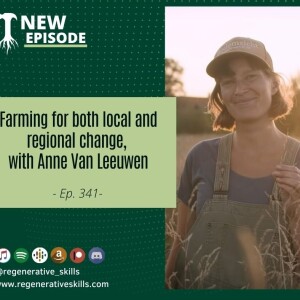
5 days ago
5 days ago
Today we’ll be continuing with the second part of my discussion with Anne Van Leeuwen from Bodemzicht in the Netherlands. In case you missed the first part, I recommend going back for some context where Anne spoke about how she and her partner Ricardo got started in Farming and the evolution of their farm at the original location. In this second half we’ll pick up where Anne begins to talk about their new farm, how they found it, and the vision they have for it’s development. We also talk about the things that they are planning to do differently from the startup of the first farm given the unusual opportunity to start, relatively, from scratch.
We explore complementary farm enterprises to ensure regular cash flow, navigating the complexities of human relationships within a multistakeholder business, and by the end we also go over her membership and participation with the European Alliance for Regenerative Agriculture, or EARA, a new lobbying organization working to shape regenerative ag policy at the European Union level.
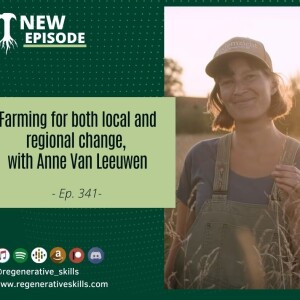
Friday May 24, 2024
Friday May 24, 2024
Today’s conversation is the first of a two part conversation with Anne Va Leeuwen from Bodemzicht in the Netherlands that I’ve been looking forward to for quite a few years. Anne and her husband Ricardo and I met for the first time at the first Climate Farmers conference in Germany 3 years ago. By then they were already building a reputation in the Dutch regen ag scene as leaders and innovators. Since then they’ve continued to take a leading role in bringing visibility to regenerative farming, the challenges that farmers face, and advocate for the creation of a regenerative agrifood system in the Netherlands and beyond. At the core of their advocacy has been the inspiring example of their own farm which not only produces high quality produce and animal products for locals, but has served as a hub for training, presentations and community gatherings since it began. I organized this interview with Anne as she and their organization have just completed a move to a new farm location. Their tenure at their original site was up and we had been in communication throughout their process of looking for new land and all of the planning, preparation, and logistics involved with moving their operation to a new place. Now that they’re getting settled, I was excited to have Anne share her learnings and experience from the process on this show. Beyond the moving experience, Anne and I also cover a lot of other topics which range from the learnings they’ve gathered in the previous years both in pioneering their innovative farm model, regenerating their environment through conscious cultivation and care, navigating the challenges in the current farming system in the Netherlands, new cooperative farming models, lobbying for European Agriculture policy reform, and much more.
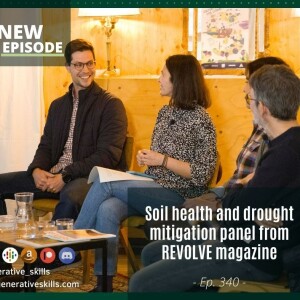
Friday May 17, 2024
Friday May 17, 2024
A couple weeks ago I was invited to speak on a panel discussion about soil health for the release of a new issue of REVOLVE magazine.
Established in 2010, REVOLVE inspires climate action by keeping you informed about the circular economy, ecosystem restoration, the energy transition, sustainable mobility and water resources.
Their latest episode focuses on the importance of soil and how to restore the health and function of soil through the perspective of researchers and practitioners. Along with Teresa Gimeno a forestry researcher with the Centro de Investigación de Ecologia y Aplicaciones Forestales or CREAF here in Catalunya, and Carlos Ortiz who works with the department of climate action at the Generalitat de Catalunya where he leads the office of fertilizers and manure treatment, were interviewed by Marta Castillo who is a journalist and communications officer with REVOLVE media. I’ll leave it there since Marta gives a great introduction to the panel and each of us as speakers right at the beginning.
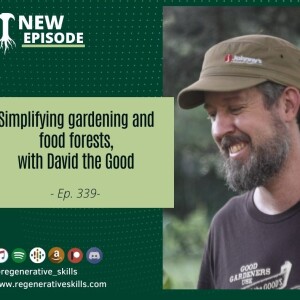
Friday May 10, 2024
Friday May 10, 2024
Continuing on the theme of last week’s episode in which I spoke with Jessica Robertson about community food forests, we’re going to go deeper into the practical knowledge and skills that anyone can develop to create their own plant nursery, propagate their favorite varieties, and get their own garden or food forest established quickly and cheaply.
Joining me for this dive into DIY plant breeding and propagation is David Goodman, better known to his fans as David the Good. David is a gardening author and teacher, focusing on simple methods to grow the most food for the least amount of work. His blog can be found at thesurvivalgardener.com, and he is on YouTube as @davidthegood.
In this discussion we’ll take a look at what concepts and realizations helped David to find success in his early gardening and growing endeavors which he uses to this day. David is a big proponent of setting up your own plant nursery and we go into his advice for getting one set up cheaply so you can save money from the garden centers and maybe even make money with it as a side hustle.
We also explore the process of selecting varieties and species that thrive in your area and conditions, and the importance of building community through your planting and breeding efforts.
I myself am in the process of setting up my own nursery and agroforestry system and I can vouch for the importance of starting your own plants, not only to save money, but to learn a valuable skill and potentially even increase the quality of plants you have access to.
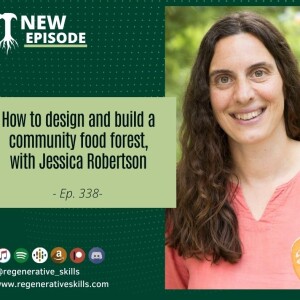
Friday May 03, 2024
Friday May 03, 2024
With the growth in popularity around permaculture and food forests, even people without access to their own land are looking into opportunities to come together and create beautiful edible landscapes that everyone can access on public land. Enter community orchards or food forests. These are increasingly being grown on abandoned lots, local parks, or forgotten strips of land that caring neighbors take interest in and decide to grow perennial food and medicine crops on. Yet as the number of people involved grows, and the need to conform to regulations and permit processes, many people can get lost in the complexities during the attempt.
To help me better understand these challenges and opportunities, I reached out to Jessica Robertson in Canada who has helped design and install a number of community food forests and helped to illuminate the process from her experience.
Jessica is the Owner, Designer, and Head Grunt at Wild Craft Permaculture and a Lead Designer at United Designers International. Jessica has designed holistic permaculture systems for spaces from 200 sq. ft. to 200-acres and works on residential, commercial, and public projects. She is often involved in the implementation of these designs and loves sharing her knowledge with clients as they work alongside each other. She brings a background in biology, education, silviculture and urban planning to her work.
In this episode, Jessica shares insights from decades of experience in the permaculture world, showing how people from all walks of life can reconnect with the earth in deeper and more active ways. We'll also work carefully through the process of designing, setting up, and keeping up with community food forests, including things people often forget about and realistic expectations for maintenance. And to top it off, we'll give you some easy steps to create your own successful community food forest right in your own neighborhood.
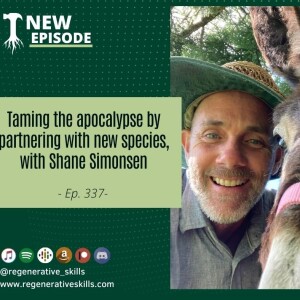
Thursday Apr 25, 2024
Thursday Apr 25, 2024
So much of what inspires me and that I hope to highlight on this show comes from an ever growing awareness of the incredible superpowers that humans have that emerge from our relationship with the natural world around us. Our senses coupled with adaptability, the skill of collaboration and the inventiveness of our creativity have allowed humans to find a niche in almost every major biome on this planet. Whether it’s forming a symbiotic relationship with the semi-wild reindeer of the arctic circle, or coastal people of the tropics evolving superior vision underwater, or our ability to communicate with wild species to understand imminent dangers or changes in the weather, or polynesian sailors being able to navigate through open ocean by sensing the patterns in the waves. Everywhere that humans have made their home, they’ve developed unique ways of understanding, adapting to, and developing deep relationships with the forms of life around them.
One of the most outstanding of our collective abilities is being able to manipulate the genes and evolution of the species around us. We’ve done this with animal and plant domestication, breeding, and propagation, and more recently, with advanced technological tools. In past episodes I’ve explored the topic of landrace gardening, low tech plant breeding, and adaptation to your place and context. This is an idea that has captivated me in the last couple years and is informing a major part of the development of my own farm.
Today I want to step out of the details of landrace plant breeding to try and understand the broader potential of what partnering with the evolutionary trajectory of selected species in our sphere of influence could look like and the mind bending possibilities that hide in that way of interacting with the environment around us.
Here to explore this concept and give ideas based on his own experiences is Shane Simionsen. Shane is a long-time contributor to this podcast so I’ll keep his introduction short and recommend you go back to some previous episodes to hear more of his back story and work, but briefly, Shane is an Australian experimental farmer developing zero input agricultural systems and writing biological science fiction.
In this conversation, we’ll be taking a look at what Shane sees as the essential moment in our developmental journey as a species to make use of the temporary ease and convenience of global trade to do the hard work of accelerating our close partnerships with the plants, animals, bacteria, and fungi around us. We take a look at how people from the dawn of our evolution have been doing this and how modern technology can play a role in bringing these cooperative relationships to new heights.
We also go into the steps and actions that anyone can take to help create climate adapted food crops and maybe even tackle the next novel domestication project. Shane gives great examples of how he’s running his own tests and experiments on his farm in Queensland, AU and shares his learnings, failures and successes to help set expectations for what a landrace or breeding project entails.
His new book “Taming the Apocalypse” is now available in digital and audiobook formats through subscription to his blog on Substack
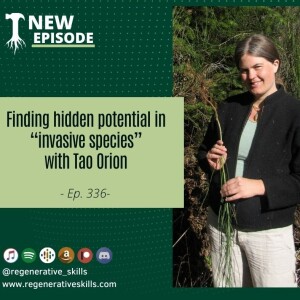
Friday Apr 19, 2024
Friday Apr 19, 2024
I’m really lucky that I have been collaborating with book publishers since the early days of this podcast. It gives me access to all of the books from the authors that I interview and the full catalogs of most of the publishers too. As a result I have a pretty good overview of the new literature that comes out on the topics that I focus on in this podcast. Under these conditions, It’s rare that a single book stands out so much in my mind for the quality and importance of the ideas in it, and for the practical examples that illustrate those concepts in a way that someone can put into action.
For me though, that book is “Beyond the War on Invasive Species” by Tao Orion. Perhaps I really connected with it because of my work in the conservation corps and the collaborations with the US forestry service and National Park Service on those jobs. The fight against invasives in those circles was very present and left an impression on me in my early career. The idea of fighting against the propagation and spread of a plant or animal never sat well with me though, but I didn’t have a way of expressing my unease about it until I read this book. The world view and perspective on our role as earth stewards that Tao outlines continues to inform so much of my work and experience on my own land. So let's get into it.
Tao Orion is the author of Beyond the War on Invasive Species: A Permaculture Approach to Ecosystem Restoration, and "“People as Purposeful and Conscientious Resource Stewards: Human Agency in a World Gone Wild” and Rethinking Wilderness and the Wild: Conflict, Conservation, and Co-Existence. Tao consults on holistic farm, forest, and restoration planning through her company Resilience Permaculture Design, LLC and works as an instructor in the Oregon State University Permaculture program. She holds a degree in agroecology and sustainable agriculture from UC Santa Cruz, and a MSc degree in Climate Change, Agriculture, and Food Security from the National University of Ireland. She lives with her husband, two children, and an array of fruits, vegetables, seeds, nuts, and animals on her southern Willamette Valley smallholding, Viriditas Farm.
In this interview, Tao and I dig through the ideas and examples in her first book from the origins of the concept of invasive species, through to the governmental policies that wage war on them in modern times. We look at how species migration has accelerated with human travel technologies and how their spread has mirrored the spread of global trade. Tao describes the paradoxes of demonizing opportunistic and displaced species and gives examples of how we can begin to look deeper into the reasons, conditions, and needs that bring about their proliferation to gain insight how we might look beyond eradication to collaboration in their management. We also talk about some tangible examples that I’m dealing with right now on my farm and local area in an attempt to uncover the hidden potential in the species that the authorities around me are working to control. I know I recommend a lot of books on this show, and for good reason, I stand by all of those recommendations. But if there’s one volume that you really take the time to understand and internalize in your way of observing and understanding the fast changing natural world around us, it’s this one.
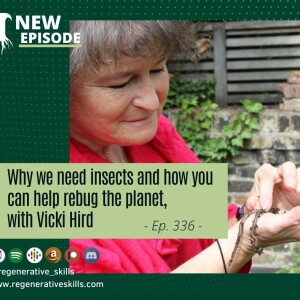
Friday Apr 12, 2024
Friday Apr 12, 2024
world of insects. Though there are only a handful of bugs and invertebrates that humans consider edible, productive, or beautiful, they are an essential element in any healthy ecosystem. All too often the ones that we don’t derive beauty from or direct use from are considered an annoyance at best or actively destroyed and eradicated in all too many cases. It’s long overdue that I highlight just how valuable insects are to out world and our own wellbeing on this show, and to help me to do that in this episode is Vicki Hird.
Vicki Hird is the Strategic Lead on Agriculture for The Wildlife Trusts UK and was until recently Head of the Sustainable Farming Campaign for Sustain: The Alliance for Better Food and Farming. She is also a published author and runs an independent consultancy. As an experienced and award-winning environmental campaigner, researcher, writer and strategist working for the past 30 years mainly on food, farming and environmental issues and solutions, Vicki has worked on government policy for many years authored ‘Perfectly Safe to Eat? The facts on food’ in 2000, and has led teams at FoE, War on Want, WSPA and SAFE Alliance. She has co-founded many organisations including Sustain, Hackney Food Partnership and the Eating Better Alliance - and has written and campaigned extensively at a global, EU and national level. Vicki’s other passion is insects and other invertebrates and she has a Masters in Pest Management and is a Fellow of the Royal Entomological Society (FRES). Her new book – ‘Rebugging the Planet-The Remarkable Things that Insects (and Other Invertebrates) Do – and Why we need to love them more’ will be our focus of today’s conversation.
Vicki helps me to understand the significance of invertebrates in ecosystems, exploring their role, challenges, and conservation efforts. Together we go over how promoting biodiversity, sustainable practices, and community engagement is crucial to protect these essential species and support whole ecosystem health.
We also cover practical actions that anyone can take to support insect habitats in their area such as adopting habitat-friendly gardening practices, advocating for conservation policies, and understanding the impact of individual actions on invertebrates to maintain the delicate balance of nature.
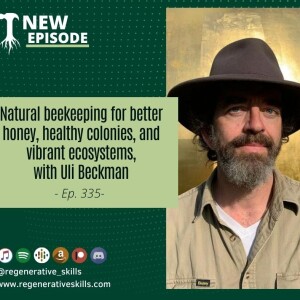
Friday Apr 05, 2024
Friday Apr 05, 2024
I’ve had the pleasure over the last few months to interview quite a few people that I admire, who’ve told me about their fascination with beekeeping. Over and over again I’ve heard about the incredible insights into overall ecological health and the amazing reflections of ecosystem function that can be observed through managing bee hives.
I got a window into the world of natural beekeeping back in May of 2022 when I co-hosted a Climate Farmer’s community event at Wilmer’s Gaerten, a regenerative farm just south of Berlin. Since then I've been looking for an opportunity to speak with Uli Beckman, the instructor on our course on beekeeping and management who helped me to see a whole new possibility in how to promote healthy colonies that in turn promote health ecosystems and people. This is exactly what today’s episode is all about.
Uli’s company, Beckmann Urtracht was founded in 2015 with the aim of consistently working in such a way that the beekeeper takes a back seat to the needs of the bees. Today, their principles and way of working far exceed anything required to be certified as an organic beekeeper. Natural propagation, natural honeycomb, built entirely by the bees, natural nutrition and minimal intervention are their maxims. Because with every jar of honey we hold in our hands, we must not forget that the bees did not produce it for us, but as food for themselves. Beckmann Urtracht is the alternative to maximizing yields and obtaining varietal honeys. The end result is an honest, original honey that can only be harvested in small quantities, but is outstanding in terms of quality and taste as well as its ecological and bee-friendly production.In todays conversation with Uli, we start by comparing and contrasting the conventional practices of industrial beekeeping and how they differ from the principles that guide natural beekeeping.
From there we go into the details of not only the life cycle and behavioral patterns of bees and how those inform how to manage them well, but also the practical side of building hives that promote their health and the environmental factors that present a real challenge to the future of the species. In the process we also unpack the history of beekeeping in Europe and the innovators how pioneered new management methods based on relationship over extraction. We cover advice on how to get started with your own hive and expectations of time and equipment for keeping bees too. I’m sure that by the end of this episode you’ll come to understand why many of the most influential and insightful people in the world of regenerative land management have become beekeepers themselves.
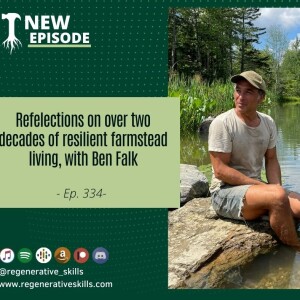
Friday Mar 29, 2024
Friday Mar 29, 2024
Despite the popularity of permaculture, homesteading, regen ag, and all these other buzz terms we hear, many of the people promoting these ideas, including myself, are quite new and inexperienced. It’s still rare to find people who can offer insight and wisdom from decades or a whole lifetime of living with regenerative systems.
Sure, you can still find quite a few hardy old timers who know a lot about resilience and self sufficiency, but even though there is a ton of wisdom to be gleaned from those life experiences I’ve found many of them lacking in the whole picture, systems level thinking that informs a regenerative world view. I’ve been lucky enough to interview and highlight some of those voices on this show in the past, and today is another example of a person who’s work and life philosophy has been a big inspiration to me. Many of you may know Ben Falk as the developer of Whole Systems Design, LLC, his company created as a land-based response to biological and cultural extinction and the increasing separation between people and elemental things. Life as a designer, builder, ecologist, tree-tender, and backcountry traveler continually informs Ben’s integrative approach to developing landscapes and buildings. His home landscape and the WSD studio site in Vermont's Mad River Valley serve as a proving ground for the regenerative land developments featured in the projects of Whole Systems Design.
Ben studied architecture and landscape architecture at the graduate level and holds a master’s degree in land-use planning and design. He has conducted more than 650 site development and land inspection consultations across the US and abroad, and has facilitated dozens of courses on property selection, permaculture design, and resilient systems. He has given keynote addresses and presented dozens of workshops at venues ranging from Bioneers to the Omega Institute.
Ben is the author of the award-winning book The Resilient Farm and Homestead (Chelsea Green, 2013) and serves as an Advisory Council for the international regeneration group Ecosystem Restoration Camps, which is incidentally how I first got in touch with him back when I worked with that organization. Today we’ll be going beyond the typical talking points of regenerative design principles, reading the landscape and life hacks for permaculture enthusiasts, partly because we already went over them in the first interview he and I did together a couple seasons ago. Instead, Ben and I explore the reflections he has on over two decades of living the lifestyle that he designs and promotes for others. We look into the biggest learnings that have come from evolving alongside and in service to perennial food systems as well as what he might do differently if he could go back and redesign things.
Ben also explains how his life experience has informed his design work and consultancy for clients, the patterns that have emerged from the endless experiments that he’s run, and where his focus is in this stage of life, both in his family and personal life as well as his work on the land. Since I’m only in the second year of designing and building my own farmstead, I find it invaluable to gain insights into all of these reflections almost as a way to peek into one of a million possible futures in hopes of setting a solid foundation and maybe avoid some pitfalls ahead.

Your Title
This is the description area. You can write an introduction or add anything you want to tell your audience. This can help potential listeners better understand and become interested in your podcast. Think about what will motivate them to hit the play button. What is your podcast about? What makes it unique? This is your chance to introduce your podcast and grab their attention.










